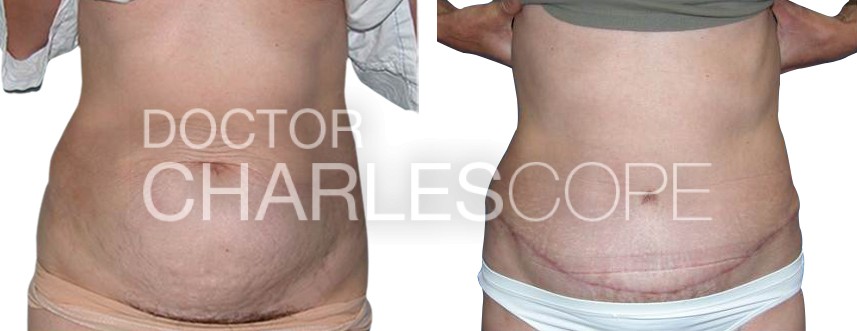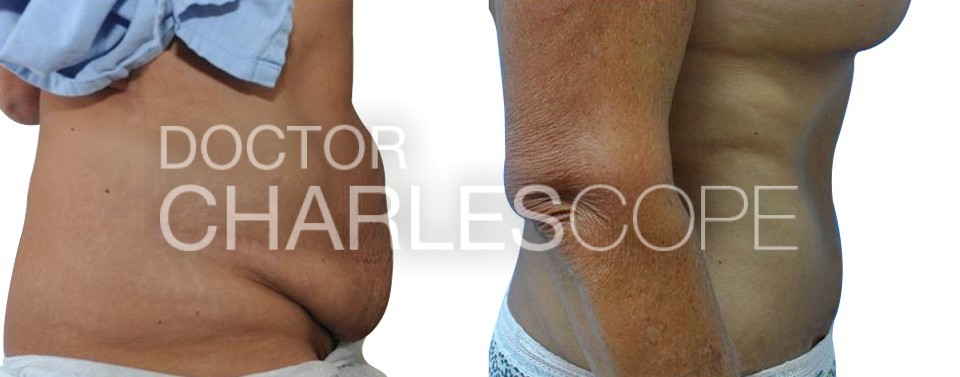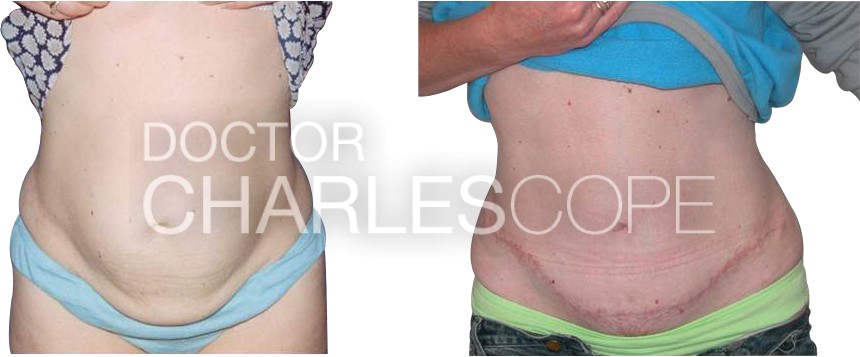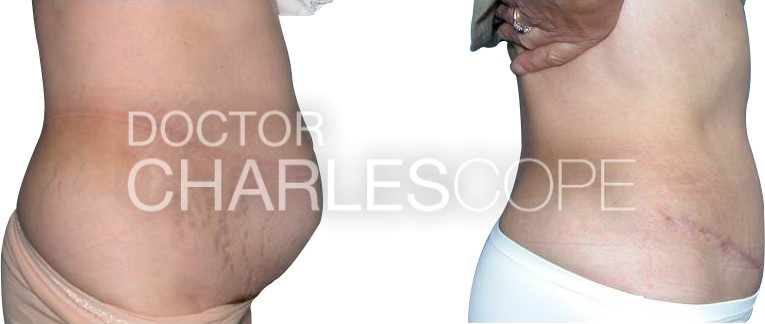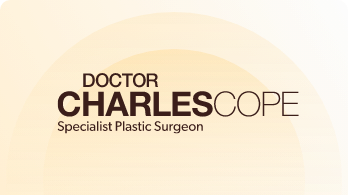Abdominoplasty (also known as tummy tuck surgery) reduces the size of the abdomen. This procedure aims to reduce skin laxity and loose muscles that often occur after pregnancy or with ageing. It does this by removing excess skin and fat from the middle and lower abdomen and tightening the muscles of the abdominal wall.
The procedure is a type of body contouring surgery that can impact both aesthetics and abdomen function. Surgeons can also perform liposuction of the hips and flanks at the same time. This can also provide additional changes to the look of your midsection. Depending on your needs, you may have different options for the type of procedure you get. The most common is a full abdominoplasty. This involves the removal of excess skin as well as addressing loose muscles beneath. There is also an extended technique, also known as a belt lipectomy, which is more extensive. Lastly, there is mini abdominoplasty, which is the least extensive option.
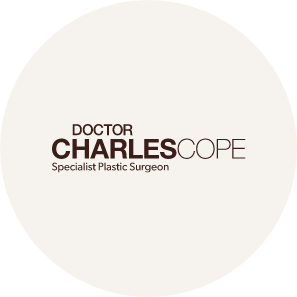
During a consultation with a surgeon, you will discuss the type of procedure you require. A qualified surgeon will be able to give you guidance on the possible outcomes, benefits, and risks. Therefore, if you believe you may benefit from abdominoplasty, consult an experienced Specialist Plastic Surgeon, such as Dr Cope in Sydney.
*Note results vary from person to person
Abdominoplasty surgery candidate
The first step in planning your surgery is finding out if you are a candidate. Not everyone is a good candidate for the procedure, so you should make sure you fit the criteria by speaking to a qualified surgeon. Dr Cope will assess your condition and inquire about your reasons for wanting surgery. As well as this, he will need to know about any health issues you may have, and what your goals are.
Both men and women can be candidates for abdominoplasty surgery. You might be a candidate if you:
- Have loose skin or muscle separation (diastasis recti) on the abdomen
- Have excess skin after pregnancy or weight loss
- Are prepared to abstain from smoking for several weeks both before and after surgery
- Are prepared to take time off work to undergo the aftercare process
- Do not have any severe health issues that may impede the surgery
- Are in good overall health
- Are at a stable body weight and have a healthy BMI
- Know the risks and possible adverse effects of surgery
- Have a realistic idea of the outcomes you may achieve
If you are unsure whether you qualify, a meeting with a Specialist Plastic Surgeon can be a great help. Dr Cope will be able to identify and explain your surgical options.
Your consultations with Dr Cope
Patients who wish to undergo surgery must have a referral from a qualified GP. This helps to ensure that the surgeon has your relevant medical history, including a screening for body dysmorphic disorder (BDD). You will not be able to proceed with surgery without a GP referral.
Following this, you will be able to consult with Dr Cope about your surgery goals. During the first consultation, it is important to express your needs and concerns honestly with your surgeon. Any relevant details about your health will be important in finding out your options and a suitable treatment plan for you. The purpose of this meeting is to get to know your needs, discuss your options, and ensure you understand what your procedure will entail. We will discuss the aftercare process, as well as the risks that you need to consider. It is a good opportunity to ask questions and ensure you are clear on the details of your surgery.
After the first meeting with your surgeon, there will be a second consultation. This allows you to ask further questions, confirm the surgery details, and provide consent. Throughout the process, Dr Cope and his team will be here to help you with any concerns you may have.
The procedure Abdominoplasty Sydney
Depending on the type of abdominoplasty surgery you undergo, the procedure and recovery can be extensive. Dr Charles Cope in Sydney performs it under a general anaesthetic and takes two to three hours. Patients will then need to stay in the hospital for three to four days.
There are several types of abdominoplasty surgery, and you will determine your options in discussion with Dr Cope. The most common techniques a surgeon may use include:
- Mini abdominoplasty: This involves a small incision in the lower abdomen in order to remove excess tissue. The surgeon will excise a precise amount of skin and fat tissue but will not address the underlying muscles. You may choose this option if you have a small amount of excess fat and do not experience any muscle division due to pregnancy.
- Full abdominoplasty: This technique is common for people with a moderate amount of excess skin and fat on the abdomen. The surgeon removes the excess tissue and may also address the muscles beneath.
- Extended abdominoplasty: This technique is also known as a belt lipectomy. It is often an option for men or women with a large amount of excess tissue on both the front and sides of the abdomen. Due to a larger incision, the surgeon is able to remove more skin and fat than is possible with other techniques.
- Liposuction: This technique may be included in addition to your surgery if you have excess deposits of fat. The procedure can help remove this excess fat tissue if it corresponds with the patient’s goals.
Depending on the amount of loose skin and fat to be removed, an incision is either made above the pubic hairline alone (mini abdominoplasty), or from hip to hip (full abdominoplasty). In the former, the umbilicus can be moved a short distance without a scar. However, in the latter, there is also a scar around the umbilicus. The surgeon removes the skin and fat between the pubic hair and the umbilicus and tightens the muscles of the abdominal wall. He then closes the skin securely with sutures.
Abdominoplasty Recovery & Aftercare Avoid Activities and Sports
The post-op recovery process can be extensive. Every patient may have a different experience in their recovery, and it’s important to prepare yourself. Planning your surgery also involves preparing for recovery, and there are a few ways to do this. For example, you may need to schedule time off work to give your body enough time to heal. People in physically demanding jobs may need more time off. You should also ensure that you have someone to drive you home after surgery, as well as support for any young children or chores around the house. Your mobility will be limited, especially in the initial stages of healing, so you should prepare well enough to ensure your needs are met.
There are certain instructions you should follow after your abdominoplasty surgery. For example, you need to wear a support garment for a few weeks and avoid heavy activities and sports for six weeks. Most people return to normal everyday activities and work after three to four weeks. The scars from surgery gradually fade and lighten in colour, although this may take a full year. However, you should know that scarring may vary in appearance, and there is a risk of poor scarring outcomes. In order to minimise your risks, there are other guidelines you will need to follow:
- Avoid smoking, as this may increase your risks
- Avoid alcohol consumption
- Give your body time to rest
- Avoid putting a strain on your abdomen
- Keep your incisions clean
- Avoid blood thinning medications
- Inform Dr Cope of any adverse symptoms
Patients who intend to lose a lot of weight should postpone the surgery until after their weight is stable. The surgery is best left until after all pregnancies have finished. This is because weight loss and pregnancy can compromise the result by producing more loose skin.
How much does abdominoplasty surgery cost in Sydney?
Several factors make up the total cost of your abdominoplasty surgery. These include the following:
Surgeon’s fee
This will depend on the surgeon’s skills and experience.
Anaesthetist’s fees
Your anaesthetist may charge by the hour or procedure.
Operating room fee
This may include the materials used during the surgery, such as gloves, sutures, and other equipment.
The type of surgery
This will depend on whether you had a full or mini abdominoplasty.
Length of hospital stay
Depending on your operation, you may be allowed to go home the next day or you may need to stay a few nights.
Extent of the surgery
The cost of your abdominoplasty surgery will depend on whether additional procedures are performed.
You may discuss all these details in depth during the consulting process. In some cases, abdominoplasty surgery is not covered by Medicare or private health insurance because it is a cosmetic procedure. If it is medically necessary, you may require surgery to remove excess skin following weight loss to reduce the risk of infection and rashes. Or, you may have a large divarication of the rectus muscles after pregnancy (>3cms). In these cases, you may attract a Medicare number and your private insurance provider may cover some of the costs.
During your initial consultation, we will give you more insight into the cost of the surgery.
Risks and Complications
It is crucial to be aware of the risks before you undergo surgery. Although you can expect to receive attentive care from a qualified Specialist Plastic Surgeon, no surgery is without risks. Patients should be well informed about the possible adverse outcomes of surgery and have a realistic vision for their outcomes.
Dr Cope will discuss the possible risks and side effects of surgery with you. If you are uncertain about anything, ensure that you ask for clarification. The possible risks of abdominoplasty surgery include:
- Seroma
- Infection
- Numbness or changes in sensation
- Slow or poor healing
- Bleeding
- Blood clotting
- Poor scarring
- Poor results
- Asymmetry
- Further surgery
- Ongoing pain or discomfort
If you are concerned about any post-op symptoms, ensure that you contact us for further guidance. Remember that some amount of pain, swelling, and bruising is normal and expected after surgery. However, if these symptoms are persistent or severe, seek medical attention.
*Note results vary from person to person
Is there a Medicare rebate for the abdominoplasty surgery?
There are very specific criteria for qualifying for a Medicare rebate for surgery after pregnancy and after large weight loss. In the case of post-pregnancy surgery, Medicare requires 3cm of muscle separation to qualify. In the case of large weight loss, the requirement is that you have greater than 5% BMI weight loss and skin irritation. These details must be documented and proven to be affecting your health, comfort, and/or quality of life.
If you qualify, your health fund may cover the hospital bed fee and theatre fee costs (depending on your level of insurance). A meeting with us can help clarify whether you meet the criteria.
Why Choose Dr Cope for Your Abdominoplasty Surgery in Sydney
When choosing a surgeon to perform your surgery, you should think about their skills and level of training. A good surgeon should be transparent about what is involved and explain your options in detail, as well as the risks. The surgeon should also be willing to explain his credentials and experience. This way, you can be fully prepared and informed before you commit to the procedure and choose your surgeon.
Dr Cope is a certified plastic surgeon who takes great care to provide bespoke treatments. He will guide and support you through the process and answer any questions you may have along the way. Caring and supportive guidance can make a large difference before a surgical procedure, and Dr Cope understands this. If you would like to learn more about this surgery and whether it’s right for you, get in touch with our team. We are happy to meet with you at one of our three clinic locations: Mosman, Wahroonga, and Gosford.
Frequently Asked Questions
Abdominoplasty surgery can be performed at any age up to about 70. If you are about to have children soon then you should wait until after pregnancy and breast feeding. This is because these often change your abdomen and the result. If you are young and this is many years away then this is not an issue. Many patients also have surgery after having children to address changes that have occurred with pregnancy and breast feeding.
People have abdominoplasty surgery at any time of the year. However, you need to wear a support garment for at least a few weeks. In some cases, this is six to eight weeks. This is more comfortable in the cooler winter months. It is also easier to disguise the garment under clothes during winter. However, people often organise surgery when they can best take time off work, at other times such as just before Christmas or in January if work is quiet then.
Many people have other procedures performed at the same time. The most common is liposuction of other areas such as love handles and thighs. Breast surgery is also common, either breast augmentation or reduction mammoplasty, or breast lift (mastopexy).
A full procedure removes all the loose skin on the lower abdomen. It also tightens the muscle layer underneath, which is often stretched after pregnancy and weight changes.
There is a less extensive option that only removes loose skin from the lower abdomen, often combined with liposuction. This often involves a faster recovery (patients often return to work within 10 days rather than three to four weeks), but does not provide dramatic results. However, for patients with only a small amount of loose skin on the lower abdomen, this may be a good option.
Many people have other procedures performed at the same time as abdominoplasty, the commonest being liposuction of other areas such as love handles and thighs. Breast surgery is also common, either breast augmentation, breast lift (mastopexy) or breast reduction.
A full procedure removes all the loose skin on the lower abdomen. It also tightens the muscle layer underneath, which is often stretched after pregnancy and weight changes.
There is a less extensive option that only removes loose skin from the lower abdomen, often combined with liposuction. This often involves a faster recovery (patients often return to work within 10 days rather than three to four weeks), but does not provide dramatic results. However, for patients with only a small amount of loose skin on the lower abdomen, this may be a good option.
Providing your weight is stable, and you do not become pregnant again, the result of the operation is often long-lasting. The effects of natural weight gain and ageing, however, can impact the results somewhat. In some cases, you may choose to undergo minor revision surgery.
Surgeons perform the surgery under general anaesthetic in an accredited hospital. Patients, on average, stay in the hospital for three nights to recover.
It is normal for scars to be red, lumpy and obvious for 6-8 weeks after surgery. After this, they typically fade to some extent and become paler after one to two years. The simplest way to help this process is to keep tape such as Micropore tape on the scars for the first three months or so. An alternative to this is to massage the scars. Uncommonly, scars stay red and thick for months, requiring other treatments such as steroid injections or vascular lasers to help them fade.
If you do not have loose skin, liposuction can reduce the amount of fat in the abdominal area. However, if you have loose skin to start off with, then a full surgical procedure may be the better option.
Non-surgical skin-tightening devices such as SkinTyte and Ultraformer III can help treat loose skin by triggering collagen contraction. Over the following six months after treatment, the collagen slowly remodels within the skin. These treatments typically have no downtime. However, they do not remove all skin laxity, and you may need multiple treatments. They may provide options if you are not ready for surgery.
During the two weeks after returning from the hospital, you need to rest and take things quietly at home. You will need help to look after young children during this time. When you go home, there will be waterproof dressings covering your abdomen, which normally stay on for a few weeks. This allows you to shower normally. You should wear your support garment the whole time, which needs to be worn for at least a few weeks (and for some people, six to eight weeks). Most people return to office work three to four weeks after abdominoplasty surgery. However, physical work may require six weeks.
*Note results may vary from person to person


